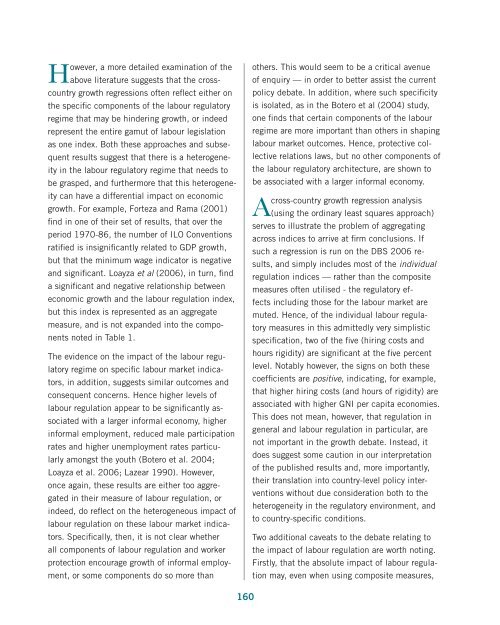Download the file - United Nations Rule of Law
Download the file - United Nations Rule of Law
Download the file - United Nations Rule of Law
You also want an ePaper? Increase the reach of your titles
YUMPU automatically turns print PDFs into web optimized ePapers that Google loves.
However, a more detailed examination <strong>of</strong> <strong>the</strong>above literature suggests that <strong>the</strong> crosscountrygrowth regressions <strong>of</strong>ten reflect ei<strong>the</strong>r on<strong>the</strong> specific components <strong>of</strong> <strong>the</strong> labour regulatoryregime that may be hindering growth, or indeedrepresent <strong>the</strong> entire gamut <strong>of</strong> labour legislationas one index. Both <strong>the</strong>se approaches and subsequentresults suggest that <strong>the</strong>re is a heterogeneityin <strong>the</strong> labour regulatory regime that needs tobe grasped, and fur<strong>the</strong>rmore that this heterogeneitycan have a differential impact on economicgrowth. For example, Forteza and Rama (2001)find in one <strong>of</strong> <strong>the</strong>ir set <strong>of</strong> results, that over <strong>the</strong>period 1970-86, <strong>the</strong> number <strong>of</strong> ILO Conventionsratified is insignificantly related to GDP growth,but that <strong>the</strong> minimum wage indicator is negativeand significant. Loayza et al (2006), in turn, finda significant and negative relationship betweeneconomic growth and <strong>the</strong> labour regulation index,but this index is represented as an aggregatemeasure, and is not expanded into <strong>the</strong> componentsnoted in Table 1.The evidence on <strong>the</strong> impact <strong>of</strong> <strong>the</strong> labour regulatoryregime on specific labour market indicators,in addition, suggests similar outcomes andconsequent concerns. Hence higher levels <strong>of</strong>labour regulation appear to be significantly associatedwith a larger informal economy, higherinformal employment, reduced male participationrates and higher unemployment rates particularlyamongst <strong>the</strong> youth (Botero et al. 2004;Loayza et al. 2006; Lazear 1990). However,once again, <strong>the</strong>se results are ei<strong>the</strong>r too aggregatedin <strong>the</strong>ir measure <strong>of</strong> labour regulation, orindeed, do reflect on <strong>the</strong> heterogeneous impact <strong>of</strong>labour regulation on <strong>the</strong>se labour market indicators.Specifically, <strong>the</strong>n, it is not clear whe<strong>the</strong>rall components <strong>of</strong> labour regulation and workerprotection encourage growth <strong>of</strong> informal employment,or some components do so more thano<strong>the</strong>rs. This would seem to be a critical avenue<strong>of</strong> enquiry — in order to better assist <strong>the</strong> currentpolicy debate. In addition, where such specificityis isolated, as in <strong>the</strong> Botero et al (2004) study,one finds that certain components <strong>of</strong> <strong>the</strong> labourregime are more important than o<strong>the</strong>rs in shapinglabour market outcomes. Hence, protective collectiverelations laws, but no o<strong>the</strong>r components <strong>of</strong><strong>the</strong> labour regulatory architecture, are shown tobe associated with a larger informal economy.Across-country growth regression analysis(using <strong>the</strong> ordinary least squares approach)serves to illustrate <strong>the</strong> problem <strong>of</strong> aggregatingacross indices to arrive at firm conclusions. Ifsuch a regression is run on <strong>the</strong> DBS 2006 results,and simply includes most <strong>of</strong> <strong>the</strong> individualregulation indices — ra<strong>the</strong>r than <strong>the</strong> compositemeasures <strong>of</strong>ten utilised - <strong>the</strong> regulatory effectsincluding those for <strong>the</strong> labour market aremuted. Hence, <strong>of</strong> <strong>the</strong> individual labour regulatorymeasures in this admittedly very simplisticspecification, two <strong>of</strong> <strong>the</strong> five (hiring costs andhours rigidity) are significant at <strong>the</strong> five percentlevel. Notably however, <strong>the</strong> signs on both <strong>the</strong>secoefficients are positive, indicating, for example,that higher hiring costs (and hours <strong>of</strong> rigidity) areassociated with higher GNI per capita economies.This does not mean, however, that regulation ingeneral and labour regulation in particular, arenot important in <strong>the</strong> growth debate. Instead, itdoes suggest some caution in our interpretation<strong>of</strong> <strong>the</strong> published results and, more importantly,<strong>the</strong>ir translation into country-level policy interventionswithout due consideration both to <strong>the</strong>heterogeneity in <strong>the</strong> regulatory environment, andto country-specific conditions.Two additional caveats to <strong>the</strong> debate relating to<strong>the</strong> impact <strong>of</strong> labour regulation are worth noting.Firstly, that <strong>the</strong> absolute impact <strong>of</strong> labour regulationmay, even when using composite measures,160
















